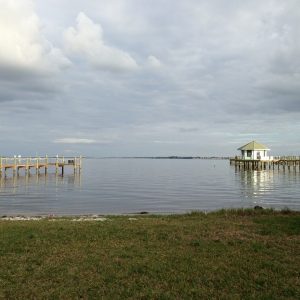The name Hickory Bluff was given to the area due to a bluff overlooking the harbor, which was forested in hickory trees. Sadly, the hickory trees were all timbered off by an axe handle factory after the Civil War. The Hickory Bluff mound was leveled in 1926 for a housing development.
Today’s Chester Roberts Park is located in the original pioneer settlement called Hickory Bluff which is now in the Charlotte Harbor Town Local Historic District. The entire area gradually became known as Charlotte Harbor after the post office was established with that name in 1872.
Attempts to refer to unincorporated community as Charlotte Harbor Town in the 1990s to distinguish it from the Charlotte Harbor Bay have not endured into the 21st century, except for the name of the local historic district established in 1993.
Hickory Bluff Pioneers Historical Marker
The text on the marker reads as follows:
“After the Civil War (1861-1865), soldiers stationed in Florida decided to stay for the warm climate as well as for political and financial gain. Some became early pioneers here in Hickory Bluff, not far from the 1872 Charlotte Harbor post office.
“Lt. Nathan H. De Coster and Capt. John F. Bartholf were Union soldiers stationed at Ft. Myers. After marrying Florida women, they homesteaded in this area. John Lomans, an African-American soldier also serving at Ft. Myers, helped De Coster set up the first sawmill south of Tampa. Lomans later served as volunteer registrar and De Coster became a county judge, postmaster and customs inspector. Bartholf was superintendent of public instruction when schools were established throughout the Peace River region, including Hickory Bluff in 1873. The first school house was constructed with boards sawn at De Coster’s mill.
“Mathieu F. Giddens was a former Confederate soldier who owned a farm on Mill Creek and served as county commissioner. Giddens donated land for the Charlotte Harbor Cemetery after his father-in-law, Joel Knight, died in 1879.
“Francis Durrance, Jr. owned a house and cattle in eastern Hickory Bluff. He was customs collector in Punta Gorda and served as the local preacher. Around 1927, his son, Cleveland Pasco Durrance, built a Mediterranean Revival style home (called locally the “Spanish House,” now demolished) near this site. He later moved his family to the house next door and rented the Spanish House to seasonal tourists.”

